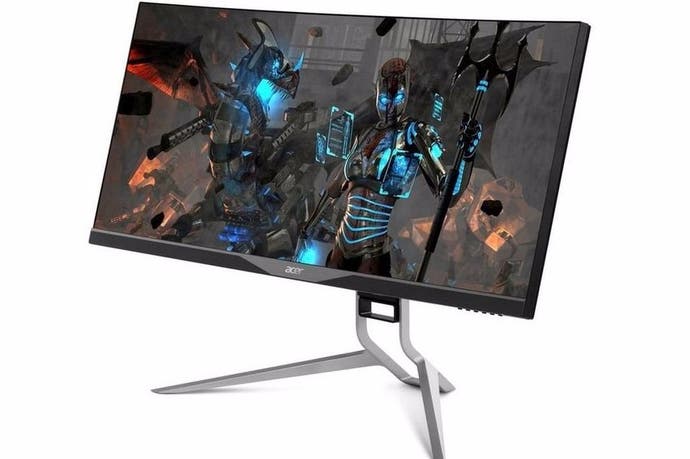Acer X34 Predator vs XR341CK: two ultra-wide gaming displays reviewed
Curved 21:9 screens with 3440x1440 resolution, IPS panels, G-Sync/FreeSync support and more.
Is 4K really the future of gaming? A quick look at the Steam hardware survey reveals that 1080p is the dominant gaming resolution, with all others occupying less than one per cent of the market. In short, the long term migration to 1440p and 4K is by no means a fait accompli and there's room for PC display tech to evolve in different, more intriguing directions. All of which leads us to the new wave of ultra-wide 21:9 aspect ratio displays and this brace of excellent new monitors: the Acer X34 Predator and the XR341CK.
Both represent Acer's continuing push into the enthusiast gaming market - these are 34-inch curved displays with superb build quality, high-end materials and enthusiast-friendly features. Resolution is a superb 3440x1440 on both, offering a 33 per cent increase in horizontal resolution over a standard 2560x1440 screen. Both are equipped with state-of-the-art adaptive sync technologies - G-Sync on the X34 Predator and FreeSync on the XR341CK. Effectively, Acer's focus on the high-end enthusiast is neatly divided between owners of AMD and Nvidia graphics hardware, with nobody missing out.
Both the Acer XR341CK and Predator displays use IPS panels that feature impressive colour performance out the box without the need for extensive calibration to accurately hit the Rec.709 and D65 standards for high definition material - setting gamma to 2.4/2.5 along with configuring the brightness (backlight) to suit your viewing environment is all most people will need to do to get a natural image. The form factor and subtle curved screen are also identical between the two monitors.
Viewing angles are generous, though black levels are distinctly average (0.12 cdm2) with these appearing like a dark grey in dim lighting conditions. HDMI 2.0 is also supported, enabling resolutions beyond 1080p at 60fps without needing to use DisplayPort, although we found Windows 10 often limiting the monitor to 30Hz despite the connection having enough bandwidth to deliver higher refresh rates.
- Order the Acer X34 Predator or the Acer XR341CK from Amazon with free shipping.
Functionality is similar too: both screens support variable refresh rates, with the AMD FreeSync-equipped XR341CK topping out at 75Hz. Meanwhile, the Predator is limited to 60Hz out of the box, although there is an option to overclock the display in order to enable refresh rates up to 100Hz. However, both AMD and Nvidia variable refresh options can only be used when hooking up the GPU by DisplayPort, as the current HDMI specifications only support fixed refresh rates.
Connectivity options divide the two screens, however. The utilisation of G-Sync limits the inputs of the X34, restricted to just a single HDMI and DisplayPort. Meanwhile, the XR341CK luxuriates in available ports - twin HDMI (2.0 and MHL support), DisplayPort in both mini and full-size configurations, plus a DP out for daisy-chaining multiple screens. On top of this, the XR341CK features picture-in-picture and picture-by-picture support unseen on the X34. However, both screens do feature the same quad-port USB 3.0 hub.
In terms of day-to-day work and play, these two screens offer a very similar experience. Sitting roughly 2.5 image heights away from both Acer displays, the ultra-wide 21:9 screen delivers a panoramic view to the presentation in games featuring large scale environments - such as Just Cause 3 and Star Wars Battlefront - with the gentle curve helping to subtly wrap scenery around the edge of our field of vision. With the view of the environment opened up, the extra visibility on offer works well in better immersing us into the world. Details fill out field of vision in a way that setting closer to a traditional 16:9 display can't quite match, and this results in an image that feels more cinematic, and often larger in scope. The extra field of view also comes in handy when surveying the battlefield in FPS titles, allowing you to spot enemies across a wider area of the environment.
Movies also benefit from the same increase in screen space. Films shot in scope (2.35:1 and 2.39:1/2.40:1) are 33 per cent wider than those shot in aspect ratios close to 16:9, and this helps to deliver an extra panoramic sense of scale to the proceedings. Essentially, you are getting a visual experience more in line with what the director intended compared to the bordered presentation on a normal 16:9 display. One downside is that 1080p content has to scale heavily in order to fill the screen. After the borders are cropped out, the actual movie only fills around 800 lines of vertical resolution, leading to some soft-looking imagery when these videos are resized to 1440p.
On top of that, getting movies to be displayed correctly on the Acers can be problematic. There's no option for vertical crop and zoom, so non-anamorphic scope content like Blu-rays and some PS4 games (such as The Order 1886 and The Evil Within) do not fill the screen correctly. Both the Acer XR341CK and the X34 Predator only offer options to horizontally stretch a 16:9 image to fill the screen at the sides, or to display this at the correct aspect ratio - but that's it. Essentially, this means it's impossible to hook up a PS4 or Blu-ray player to the monitor and enjoy ultra-wide gaming and movies with content produced in wider aspect ratios - the black borders are part of the 1080p 16:9 image and remain at the top and bottom of the screen. In order to get around this issue, you'll need to play back Blu-ray movies on a PC and use software such as VLC media player to crop out the black bars and get a true 21:9 full screen image.
In terms of the curve, this aspect serves to subtly enhance the way content is displayed, with the bend often blending away into the background when gaming, rather than intrusively warping the image around you in an unnatural manner. However, the effect only really works when the display fills your field of view. Increase your viewing distance by a few feet and the curve starts to look unnatural. The effect also doesn't quite suit productivity tasks. The inwards bend on the sides makes icons and text look a little odd - desktop icons and the menu bars in the top left in programs tend to appear a little closer compared to information at the centre of the screen. This effect works well when watching moves and playing games, but takes some time to get used to when video editing or web browsing on the monitor.
On the other hand, the expanded 21:9 aspect ratio makes video editing using software like Premiere easier: more of the timeline is visible without needing to zoom in, while there's extra space to have additional effects and video windows on screen compared to when using a 16:9 display. On the desktop, more icons and windows can be displayed on the taskbar, while the extra space would also work well for splitting the screen into two separate workspaces, making it easier to have multiple windows and programs open and on screen at once.
Aside from the ultra wide aspect ratio, the other major feature of the Acer XR341CK is the support of variable refresh gaming via AMD's FreeSync technology, while the X34 Predator supports Nvidia's G-Sync instead. However, the XR341CK's refresh is fixed at 75Hz during desktop use, with 60Hz video content featuring judder when played back. We tried overriding Windows 10's refresh rate settings via the AMD control panel, but this didn't give us the desired 60Hz update. By comparison, the Predator features a max 60Hz refresh by default, allowing for smooth playback of 30 and 60fps sources, plus there's easy scalability to higher refreshes up to 100Hz if you want them. It's clearly the more versatile display in this regard, and the flexibility with refresh rates comes in handy - especially for those working in video production.
| 4K vs 1440p Ultra-Wide | R9 Fury X 3440x1440 | R9 Fury X 3840x2160 | GTX 980 Ti 3440x1440 | GTX 980 Ti 3840x2160 |
|---|---|---|---|---|
| Assassin's Creed Unity, Very High, FXAA | 39.6 | 25.3 | 40.8 | 26.5 |
| Battlefield 4, High, Post-AA | 74.4 | 51.0 | 91.2 | 61.0 |
| Crysis 3, High, SMAA T2x | 77.0 | 52.2 | 81.3 | 49.2 |
| COD Advanced Warfare, Console Settings, FXAA | 107.0 | 85.3 | 120.5 | 86.9 |
| Far Cry 4, Very High, SMAA | 68.7 | 47.1 | 67.5 | 50.5 |
| Ryse: Son of Rome, Normal, SMAA | 67.7 | 44.0 | 64.3 | 41.7 |
- Order the Radeon R9 Fury X or the GeForce GTX 980 Ti from Amazon with free shipping.
Adaptive sync is often touted as a means by which judder can be removed entirely from the gameplay experience, but this isn't the case - the effect is minimised but the persistence of each frame is still variable, which can impact the experience in many gaming scenarios. Our recommendation here is to cap the frame-rate at a level sustainable by the GPU under load: so if you're getting between 45-65fps a good solution would be to cap at 45fps to gain a more consistent experience. It's at this point that the strengths of adaptive sync make themselves known - any arbitrary value above the screen's minimum refresh rate can be chosen, and outside of eSports scenarios, generally the human eye tends to favour a consistent update.
This provides a great alternative to a 60fps update while maxing graphical settings on demanding titles. Compared to a traditional monitor fixed to a 60Hz output, Just Cause looks and feels very, very similar locked to 50Hz, for example. Motion and controller response look and feel smooth, and even running at 45fps on a variable sync display provides a great middle ground between the chasm between 30/60fps.
Of course, both of these screens offer very high refresh rates for those looking for the most responsive gaming experience. Running at 100Hz on the Predator and at a maximum 75Hz on the XR341CK, visual motion appears similar to 60fps gaming, but the feel of the controls changes markedly for the better: input latency is reduced: controls feel snappier and analogue stick precision comes closer to replicating the feel of a mouse when it comes to fast movement. Meanwhile, mouse movement gains significantly, helped still further by the displays' low latencies. Measured at just 10ms on both Acer monitors, the gaming experience here is simply superb.
Running at 100Hz on the Predator reduces the amount of ghosting compared to running the display at 60Hz, with there being a little more clarity in fast moving scenes. However, motion resolution remains unchanged: 300 lines of detail is all the Acer XR341CK and the X34 Predator can manage, in line with the vast majority of LCDs available. This doesn't change when using the overdrive option, although setting this to normal helps to reduce visible ghosting.
Acer XR341CK vs Acer X34 Predator: the Digital Foundry verdict
Acer's two-pronged assault on the top-end enthusiast display market pays in spades with both of these displays - the pair of them are often compared but the bottom line here is simple: both are excellent, and the choice of which one to buy boils down to whether you're invested in the AMD or Nvidia graphics ecosystems. Both have their strengths: for the X34 Predator, it's the easy overclocking and the G-Sync support. Meanwhile, the XR341CK's enhanced inputs and PbP/PiP support stack up alongside its FreeSync functionality in offering features not available on the X34.
The commonalities between the two display far outweigh the differences - in effect, both of them offer a logical upgrade in pixel density over standard 1440p, commensurate with the increased GPU power offered by top-end cards like the GTX 980 Ti and the R9 Fury X. They're effectively 30 per cent faster than the GTX 980 and the R9 390X, and with these screens they're powering a 33 per cent increase in pixel count over standard 1440p. The end result is that you get a new, panoramic outlook on supported games - by contrast, 4K is still 16:9 - just with a much higher pixel density, which even the top-end cards can struggle to accommodate.
Criticisms? Well, overall build quality on both screens is excellent, but we're not enormously enamoured with the glossy rear plastics, while just two inputs on the X34 Predator - a necessary limitation owing to the G-Sync module - does feel somewhat limited for a premium price display. And the XR341CK and X34 Predator are both very pricey too - it's £900 for the XR and £100 more for the G-Sync-equipped Predator variant. We hope to see prices gravitate downwards as competition in this sector increases, but suffice to say that quality at this level never comes cheap in the PC space.


















